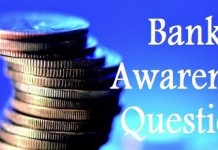Hello Aspirants,
Welcome to Banking Awareness Quiz in AffairsCloud.com. Here we are creating quiz covering important questions which are common for all the bank exams and other competitive exams.
- A fund that tracks an index but can be traded like a stock is known as _______
A. Exchange Traded Funds(ETF)
B. Mutual Funds
C. Energy Funds
D. Investment Fund
E. None of the AboveA. Exchange Traded Funds(ETF)
Explanation:
An ETF(Exchange Traded Fund) is a marketable security that tracks an index, a commodity, bonds, or a basket of assets like an index fund. Unlike mutual funds, an ETF trades like a common stock on a stock exchange. - ________ are financial markets for the buying and selling of long-term debt or equity-backed securities.
A. Bullion Market
B. Capital Market
C. Money Market
D. All of the Above
E. None of the AboveB. Capital Market
Explanation:
Capital market is a market where buyers and sellers engage in trade of financial securities like bonds, stocks, etc - A market established for the buying and selling of precious metals such as Gold and Silver is termed as ________
A. Bullion Market
B. Capital Market
C. Money Market
D. All of the Above
E. None of the AboveA. Bullion Market
Explanation:
A market established for the buying and selling of precious metals such as Gold and Silver is termed as Bullion Market. - Which of the following is a currency established as money by government regulation or law but it is not backed by any commodity, such as gold, silver etc., but only by the faith of the bearer?
A. Commodity Money
B. Representative Money
C. Fiat Money
D. fiduciary currency
E. None of the AboveC. Fiat Money
Explanation:
Fiat money is currency that a government has declared to be legal tender, but it is not backed by a physical commodity. - Which of the following is a form of money that has an intrinsic value, like gold coins?
A. Commodity Money
B. Representative Money
C. Fiat Money
D. fiduciary currency
E. None of the AboveA. Commodity Money
Explanation:
Commodity Money is a form of currency in which the value of the currency comes from the material of which it is made. - Paper Money issued on the credit of a bank or government is called ______
A. Commodity Money
B. Representative Money
C. Fiat Money
D. Fiduciary currency
E. None of the AboveD. Fiduciary currency
Explanation:
Fiduciary Money that depends for its value on confidence that it is an accepted medium of exchange. It originated as a paper certificate that was a promise to pay a certain amount of gold or silver to the bearer. - Any type of money that has face value greater than its value as material substance is known as _______
A. Commodity Money
B. Representative Money
C. Fiat Money
D. fiduciary currency
E. None of the AboveB. Representative Money
Explanation:
A claim on a commodity, for example gold certificates or silver certificates. Any type of money that has face value greater than its value as material substance is called Representative Money. - Loan and Advances of a bank come under which of the following category?
A. Assets
B. Liabilities
C. Deposits
D. All of the Above
E. None of the AboveA. Assets
Explanation:
Anything tangible or intangible that can be owned or controlled to produce value and that is held to have positive economic value is considered an asset. Anything tangible or intangible that can be owned or controlled to produce value and that is held to have positive economic value is considered an asset. - NABARD was established on the recommendations of the ______________
A. Public Accounts Committee
B. Shivaraman Committee
C. Narasimham Committee
D. All of the Above
E. None of the AboveB. Shivaraman Committee
Explanation:
NABARD was established on the recommendations of Shivaraman Committee, (by Act 61, 1981 of Parliament) on 12 July 1982 to implement the National Bank for Agriculture and Rural Development Act 1981. - RBI sold its stake in NABARD to the Government of India, which now holds _____ stake
A. 65%
B. 70%
C. 95%
D. 99%
E. None of the AboveD. 99%
Explanation:
RBI sold its stake in NABARD to the Government of India, which now holds 99% stake.
AffairsCloud Recommends Oliveboard Mock Test
AffairsCloud Ebook - Support Us to Grow
Govt Jobs by Category
Bank Jobs Notification


